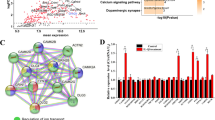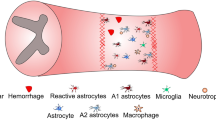Abstract
Many cellular responses to Ca2+ signals are mediated by Ca2+/calmodulin-dependent enzymes, among which is the Ca2+/calmodulin-dependent protein kinase II (CaMKII). CaMKII was originally described in rat brain tissue. In rat brain, four different subunits of the kinase have been identified: α, β, γ, and δ. This study aims to investigate changes of CaMKIIδ after traumatic brain injury and its possible role. Rat traumatic brain injury (TBI) model was established by controlled cortical injury system. In the present study, we mainly investigated the expression and cellular localization of CaMKIIδ after traumatic brain injury. Western blot analysis revealed that CaMKIIδ was present in normal rat brain cortex. It gradually increased, reached a peak at the third day after TBI, and then decreased. Importantly, more CaMKIIδ was colocalized with neuron. In addition, Western blot detection showed that the third day postinjury was also the apoptosis peak indicated by the elevated expression of caspase-3.Importantly, immunohistochemistry analysis revealed that injury-induced expression of CaMKIIδ was colabeled by caspase-3 (apoptosis cells marker). Moreover, pretreatment with the CaMKII inhibitor (KN62) reduced the injury-induced activation of caspase-3. Noticeably, the CaMKII inhibitor KN-62 could reduce TBI-induced cell injury assessed with lesion volume and attenuate behavioral outcome evaluated by motor test. These data suggested that CaMKIIδ may be implicated in the apoptosis of neuron and the recovery of neurological outcomes. However, the inherent mechanisms remained unknown. Further studies are needed to confirm the exact role of CaMKIIδ after brain injury.







Similar content being viewed by others
References
Banno Y, Nemoto S, Murakami M et al (2008) Depolarization-induced differentiation of PC12 cells is mediated by phospholipase D2 through the transcription factor CREB pathway. J Neurochem 104:1372–1386
Chang L, Zhang J, Tseng YH et al (2007) Rad GTPase deficiency leads to cardiac hypertrophy. Circulation 116:2976–2983
Chen Y, Jiang Y, Yue W, Zhou Y, Lu L, Ma L (2008) Chronic, but not acute morphine treatment, up-regulates alpha-Ca2+/calmodulin dependent protein kinase II gene expression in rat brain. Neurochem Res 33:2092–2098
Chen J, Wu X, Shao B et al (2011) Increased expression of TNF receptor-associated factor 6 after rat traumatic brain injury. Cell Mol Neurobiol 31:269–275
Clark RS, Chen J, Watkins SC et al (1997) Apoptosis-suppressor gene bcl-2 expression after traumatic brain injury in rats. J Neurosci 17:9172–9182
Clark RS, Kochanek PM, Watkins SC et al (2000) Caspase-3 mediated neuronal death after traumatic brain injury in rats. J Neurochem 74:740–753
Currie S, Elliott EB, Smith GL, Loughrey CM (2011) Two candidates at the heart of dysfunction: the ryanodine receptor and calcium/calmodulin protein kinase II as potential targets for therapeutic intervention-An in vivo perspective. Pharmacol Ther 131:204–220
Donai H, Murakami T, Amano T, Sogawa Y, Yamauchi T (2000) Induction and alternative splicing of delta isoform of Ca(2+)/calmodulin-dependent protein kinase II during neural differentiation of P19 embryonal carcinoma cells and during brain development. Brain Res Mol Brain Res 85:189–199
Elliott MB, Jallo JJ, Barbe MF, Tuma RF (2009) Hypertonic saline attenuates tissue loss and astrocyte hypertrophy in a model of traumatic brain injury. Brain Res 1305:183–191
Erhardt L (1996) Biochemical markers in acute myocardial infarction—the beginning of a new era? Eur Heart J 17:1781–1782
Garic A, Flentke GR, Amberger E, Hernandez M, Smith SM (2011) CaMKII activation is a novel effector of alcohol’s neurotoxicity in neural crest stem/progenitor cells. J Neurochem 118:646–657. doi:10.1111/j.1471-4159.2011.07273.x
Han J, Ding JH, Byeon CW et al (2011) SR proteins induce alternative exon skipping through their activities on the flanking constitutive exons. Mol Cell Biol 31:793–802
House SJ, Singer HA (2008) CaMKII-delta isoform regulation of neointima formation after vascular injury. Arterioscler Thromb Vasc Biol 28:441–447
House SJ, Ginnan RG, Armstrong SE, Singer HA (2007) Calcium/calmodulin-dependent protein kinase II-delta isoform regulation of vascular smooth muscle cell proliferation. Am J Physiol Cell Physiol 292:C2276–C2287
Houston CM, Hosie AM, Smart TG (2008) Distinct regulation of beta2 and beta3 subunit-containing cerebellar synaptic GABAA receptors by calcium/calmodulin-dependent protein kinase II. J Neurosci 28:7574–7584
Huang T, Solano J, He D, Loutfi M, Dietrich WD, Kuluz JW (2009) Traumatic injury activates MAP kinases in astrocytes: mechanisms of hypothermia and hyperthermia. J Neurotrauma 26:1535–1545
Jackson KJ, Walters CL, Damaj MI (2009) Beta 2 subunit-containing nicotinic receptors mediate acute nicotine-induced activation of calcium/calmodulin-dependent protein kinase II-dependent pathways in vivo. J Pharmacol Exp Ther 330:541–549
Jeruc J, Vizjak A, Rozman B, Ferluga D (2006) Immunohistochemical expression of activated caspase-3 as a marker of apoptosis in glomeruli of human lupus nephritis. Am J Kidney Dis 48:410–418
Ji X, Liu W, Xie K et al (2010) Beneficial effects of hydrogen gas in a rat model of traumatic brain injury via reducing oxidative stress. Brain Res 1354:196–205
Ju BG, Solum D, Song EJ et al (2004) Activating the PARP-1 sensor component of the groucho/TLE1 corepressor complex mediates a CaMKinase IIdelta-dependent neurogenic gene activation pathway. Cell 119:815–829
Kamata A, Takeuchi Y, Fukunaga K (2006) Identification of the isoforms of Ca2+/calmodulin-dependent protein kinase II and expression of brain-derived neurotrophic factor mRNAs in the substantia nigra. J Neurochem 96:195–203
Kline AE, Massucci JL, Zafonte RD, Dixon CE, DeFeo JR, Rogers EH (2007) Differential effects of single versus multiple administrations of haloperidol and risperidone on functional outcome after experimental brain trauma. Crit Care Med 35:919–924
Königsmark BW (1970) In: Nauta WJH, Ebbesson SOE (eds) Methods for counting of neurons. Contemporary research methods in neuroanatomy. Springer, New York, pp 315–340
Li W, Li H, Sanders PN et al (2011) The multifunctional Ca2+/calmodulin-dependent kinase II delta (CaMKIIdelta) controls neointima formation after carotid ligation and vascular smooth muscle cell proliferation through cell cycle regulation by p21. J Biol Chem 286:7990–7999
Logan A, Frautschy SA, Gonzalez AM, Baird A (1992) A time course for the focal elevation of synthesis of basic fibroblast growth factor and one of its high-affinity receptors (flg) following a localized cortical brain injury. J Neurosci 12:3828–3837
Ma Y, Cheng WT, Wu S, Wong TM (2009) Oestrogen confers cardioprotection by suppressing Ca2+/calmodulin-dependent protein kinase II. Br J Pharmacol 157:705–715
Maier LS (2005) CaMKIIdelta overexpression in hypertrophy and heart failure: cellular consequences for excitation-contraction coupling. Braz J Med Biol Res 38:1293–1302
Moreno-Delgado D, Gomez-Ramirez J, Torrent-Moreno A, Gonzalez-Sepulveda M, Blanco I, Ortiz J (2009) Different role of cAMP dependent protein kinase and CaMKII in H3 receptor regulation of histamine synthesis and release. Neuroscience 164:1244–1251
Mouton-Liger F, Thomas S, Rattenbach R et al (2011) PCP4 (PEP19) overexpression induces premature neuronal differentiation associated with Ca(2+)/calmodulin-dependent kinase II-delta activation in mouse models of down syndrome. J Comp Neurol 519:2779–2802. doi:10.1002/cne.22651
Nomura K, Takeuchi Y, Yamaguchi S, Okamura H, Fukunaga K (2003) Involvement of calcium/calmodulin-dependent protein kinase II in the induction of mPer1. J Neurosci Res 72:384–392
Nozawa Y, Nishihara K, Akizawa Y et al (2004) Protein kinase C activation by Helicobacter pylori in human gastric epithelial cells limits interleukin-8 production through suppression of extracellular signal-regulated kinase. J Pharmacol Sci 94:233–239
Polster BM, Fiskum G (2004) Mitochondrial mechanisms of neural cell apoptosis. J Neurochem 90:1281–1289
Qin Y, Zhang Z, Chen J, Ding X, Tong S, Song Z (2011) Ca(2+) disorder caused by rapid electrical field stimulation can be modulated by CaMKIIdelta expression in primary rat atrial myocytes. Biochem Biophys Res Commun 409:287–292
Raghupathi R, Conti AC, Graham DI et al (2002) Mild traumatic brain injury induces apoptotic cell death in the cortex that is preceded by decreases in cellular Bcl-2 immunoreactivity. Neuroscience 110:605–616
Reshef A, Shirvan A, Shohami E et al (2008) Targeting cell death in vivo in experimental traumatic brain injury by a novel molecular probe. J Neurotrauma 25:569–580
Rochlitz H, Voigt A, Lankat-Buttgereit B et al (2000) Cloning and quantitative determination of the human Ca2+/calmodulin-dependent protein kinase II (CaMK II) isoforms in human beta cells. Diabetologia 43:465–473
Rokita AG, Sag CM, Maier LS (2011) Heart failure. Excitation–contraction coupling and novel therapeutic options. Herz 36:94–101
Salas MA, Valverde CA, Sanchez G et al (2010) The signalling pathway of CaMKII-mediated apoptosis and necrosis in the ischemia/reperfusion injury. J Mol Cell Cardiol 48:1298–1306
Scafidi S, Racz J, Hazelton J, McKenna MC, Fiskum G (2010) Neuroprotection by acetyl-L-carnitine after traumatic injury to the immature rat brain. Dev Neurosci 32:480–487
Schnabel R, Palmer MJ, Kilpatrick IC, Collingridge GL (1999) A CaMKII inhibitor, KN-62, facilitates DHPG-induced LTD in the CA1 region of the hippocampus. Neuropharmacology 38:605–608
Schworer CM, Rothblum LI, Thekkumkara TJ, Singer HA (1993) Identification of novel isoforms of the delta subunit of Ca2+/calmodulin-dependent protein kinase II. Differential expression in rat brain and aorta. J Biol Chem 268:14443–14449
Shein NA, Grigoriadis N, Alexandrovich AG et al (2009) Histone deacetylase inhibitor ITF2357 is neuroprotective, improves functional recovery, and induces glial apoptosis following experimental traumatic brain injury. FASEB J 23:4266–4275
Shen G, Van Sickle BJ, Tietz EI (2010) Calcium/calmodulin-dependent protein kinase II mediates hippocampal glutamatergic plasticity during benzodiazepine withdrawal. Neuropsychopharmacology 35:1897–1909
Takeuchi Y, Yamamoto H, Matsumoto K et al (1999) Nuclear localization of the delta subunit of Ca2+/calmodulin-dependent protein kinase II in rat cerebellar granule cells. J Neurochem 72:815–825
Tan SE, Liang KC (1996) Spatial learning alters hippocampal calcium/calmodulin-dependent protein kinase II activity in rats. Brain Res 711:234–240
Tobimatsu T, Fujisawa H (1989) Tissue-specific expression of four types of rat calmodulin-dependent protein kinase II mRNAs. J Biol Chem 264:17907–17912
Toko H, Takahashi H, Kayama Y et al (2010) Ca2+/calmodulin-dependent kinase IIdelta causes heart failure by accumulation of p53 in dilated cardiomyopathy. Circulation 122:891–899
Tombes RM, Mikkelsen RB, Jarvis WD, Grant S (1999) Downregulation of delta CaM kinase II in human tumor cells. Biochim Biophys Acta 1452:1–11
Torkkeli PH, Panek I, Meisner S (2011) Ca(2)(+)/calmodulin-dependent protein kinase II mediates the octopamine-induced increase in sensitivity in spider VS-3 mechanosensory neurons. Eur J Neurosci 33:1186–1196
Wagner S, Ruff HM, Weber SL et al (2011) Reactive oxygen species-activated Ca/calmodulin kinase IIdelta is required for late I(Na) augmentation leading to cellular Na and Ca overload. Circ Res 108:555–565
Wang X, Zhang X, Ren XP et al (2010) MicroRNA-494 targeting both proapoptotic and antiapoptotic proteins protects against ischemia/reperfusion-induced cardiac injury. Circulation 122:1308–1318
Yang C, Zhou L, Gao X et al (2011) Neuroprotective effects of bone marrow stem cells overexpressing glial cell line-derived neurotrophic factor on rats with intracerebral hemorrhage and neurons exposed to hypoxia/reoxygenation. Neurosurgery 68:691–704
Zhang T, Miyamoto S, Brown JH (2004) Cardiomyocyte calcium and calcium/calmodulin-dependent protein kinase II: friends or foes? Recent Prog Horm Res 59:141–168
Zhao W, Yang J, Shi W et al (2011) Upregulation of p21-activated Kinase 6 in rat brain cortex after traumatic brain injury. J Mol Histol 42:195–203
Acknowledgments
This work was supported by the National Natural Science Foundation of China (No.30872666, No.81172911); Natural Science Foundation of Medical College of Nantong University (No.Y200905, No.Y201003); A Project Funded by the Priority Academic Program Development of Jiangsu Higher Education Institutions (PAPD).
Author information
Authors and Affiliations
Corresponding authors
Additional information
M. Zhang and H. Shan contributed equally to this work.
Rights and permissions
About this article
Cite this article
Zhang, M., Shan, H., Gu, Z. et al. Increased Expression of Calcium/Calmodulin-Dependent Protein Kinase Type II Subunit Delta after Rat Traumatic Brain Injury. J Mol Neurosci 46, 631–643 (2012). https://doi.org/10.1007/s12031-011-9651-y
Received:
Accepted:
Published:
Issue Date:
DOI: https://doi.org/10.1007/s12031-011-9651-y




